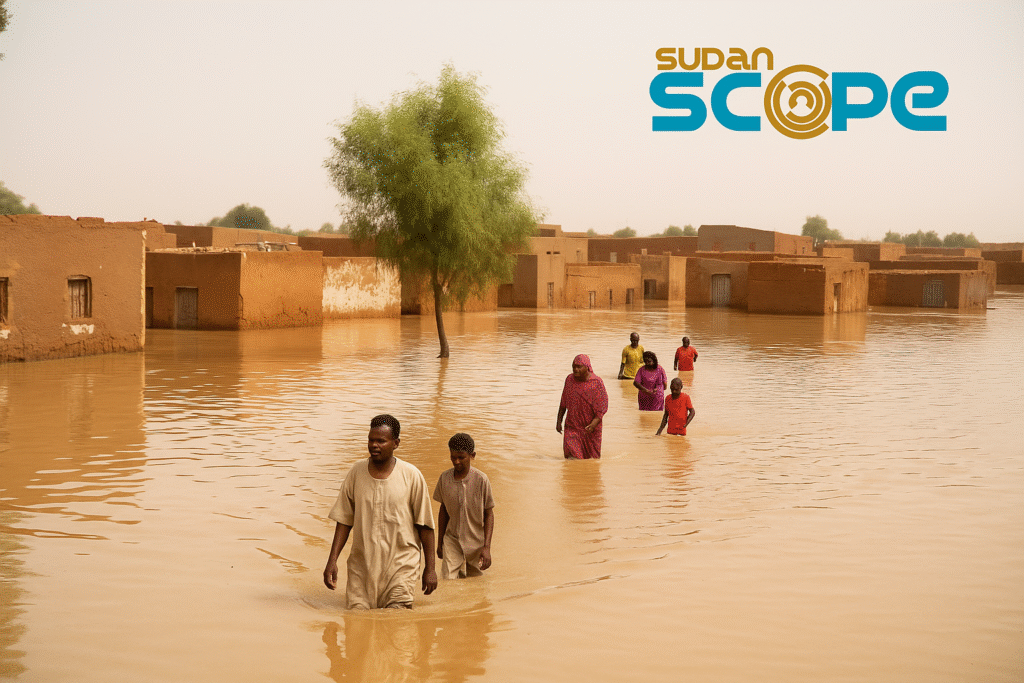Sudan Scope Editorial Team – Exclusive
For more than two years, Sudan has been enduring its political crisis, the ongoing war between the Sudanese Armed Forces (SAF) and the paramilitary group the Rapid Support Forces (RSF). However, there is another crisis accompanying the war, that is the climate change spreading across all Sudan’s states.
For environmental and climate scientists, the Earth is facing a triple crisis: climate change, biodiversity loss, and pollution. This crisis threatens the entire planet, with developing countries being the most vulnerable. Numerous international climate reports confirm that Sudan is particularly at risk of becoming one of the first regions to become uninhabitable due to climate change caused by global warming.
In a statement to CNN, climate scientist Jos Lelieveld, a researcher at the Max Planck Institute for Chemistry, said:
“North Africa is already hot. Temperatures continue to rise, and at some point, during this century, parts of this region will become uninhabitable. This includes an area stretching from Morocco to Saudi Arabia.”
According to a recent study by Dr. Rehab Mohamed Al-Hassan, coordinator of Sudan’s Third National Communication Project on Climate Change, greenhouse gas emissions increased by 50% between 1970 and 2004 compared to pre-industrial levels. The Internal Displacement Monitoring Centre (IDMC) notes that irregular rainfall has destroyed crops, causing Sudan to suffer from both droughts and floods that render land uncultivable. As a result, more than 600,000 people were displaced between 2013 and 2018 due to flood-related crises.
In the same context, Dr. Moatasem Nimir, head of the Sudanese Environmental Protection Society, states that temperatures have risen by 2.1°F (approximately 1.2°C) over the past century and are expected to rise by 8.6°F (approximately 4.8°C) over the next hundred years.
Research conducted by Dr. Abdelilah Mohamed Al-Hassan Abdelsalam, Dean of the Faculty of Environmental and Health Sciences at the University of Gezira, and published in the Assiut Environmental Studies Journal, states that sorghum production in western Sudan is expected to decline by 80%, leading to a regional food crisis and mass displacement. He also noted that gum arabic production, which accounts for 85% of the global supply and is a key Sudanese crop, may decline by 25–30%, negatively impacting the country's national GDP. He also warned of increased malaria transmission, especially between October and December, along with worsening desertification, soil degradation, and more frequent dust storms.
A 2016 joint report by the Ministry of Agriculture and Forestry in Sudan and the World Bank revealed that 65% of Sudan’s population relies on agriculture, which accounts for 30–35% of the national income. The FAO’s 2018 report confirmed that half of Sudan’s labor force is engaged in agriculture.
Sudan’s climate is changing due to rising temperatures, irregular rainfall, increased droughts and floods, and sea level rise. One of the most significant impacts is the decline in food production.
Sudan relies heavily on fossil fuels, including wood, charcoal, petroleum, and agricultural and animal waste, which exposes the population to various forms of pollution. According to the United Nations Environment Program (UNEP), 56% of Sudan’s energy supply comes from fossil fuels, 39% from petroleum-based sources (gasoline, diesel, heavy oils), and 5% from hydropower.
According to the Sudan Meteorological Authority’s 2019 report, peak temperatures in Sudan range between 41–47°C throughout the year, which are extremely high levels. The desert environment and persistent drought make the country prone to dust storms, a major source of air pollution.
Desert land covers about 72% of Sudan’s territory, and arable land amounts to 87.4 million acres, of which only 22.66 million acres (21.3%) are utilized, according to the Ministry of Agriculture (2018).
According to a FAO study, vegetation cover in Sudan was 40% in 1950, fell to 27% by the early 2000s, and then shrank to just 10.3% by 2015. This decline was compounded by the loss of one-third of Sudan’s area due to the secession of South Sudan in 2011.
The Director of UNEP Sudan country program, Atilla Uras, stated that the desert has expanded southward by about 200 km and continues to grow at a rate of 4–5 km per year. Additionally, unprecedented rises in the Blue Nile’s water level have caused flooding in 17 out of Sudan’s 18 states. In a country heavily dependent on natural resources, this situation poses a direct threat to peace, water and food security, and public health.
All the above studies were conducted before the outbreak of the war on April 15, 2023. Notably, environmental degradation had already reached alarming levels even under a relatively stable central government, despite regional conflicts. Now, with the complete absence of state authority and the military’s full engagement in war, the environmental situation is expected to deteriorate further, with no effective mechanisms in place to address it.
Agricultural activities have halted in many conflict areas, and vegetation cover has noticeably declined. The war has also produced new environmental challenges, such as the presence of thousands of corpses in the streets and the Nile River, posing a serious threat of health disasters and epidemics that endanger the population, especially the most vulnerable: children, the elderly, pregnant women, and those with chronic illnesses or disabilities.

